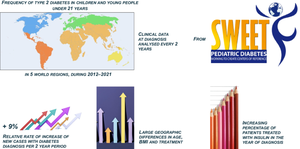Diabetologia ( IF 8.4 ) Pub Date : 2024-11-06 , DOI: 10.1007/s00125-024-06283-5 Rosaria Gesuita, Alexander J. Eckert, Stéphane Besançon, Nancy A. Crimmins, Fred Cavallo, Jaehyun Kim, Craig Jefferies, Evelien F. Gevers, Anastasios Vamvakis, Sejal Shah, Shazhan Amed, Valentino Cherubini

|
Aims/hypothesis
The diagnosis of type 2 diabetes is increasing in young people worldwide. This study evaluated the frequency and clinical characteristics of young people presenting with type 2 diabetes from the multinational SWEET e.V Registry 2012–2021, including the first years of the COVID-19 pandemic.
Methods
This is a longitudinal observational study based on the SWEET Registry, which collects demographic and clinical data on children and adolescents with diabetes from centres worldwide, with the diagnosis and classification of diabetes provided locally by each centre according to International Society for Paediatric and Adolescent Diabetes definitions. By July 2022, the SWEET Registry included 96,931 individuals from 130 centres with a total of 1,154,555 visits. Data were analysed by region: Europe (EU), Australia and New Zealand (AU/NZ), South America (SA), North America (NA) and Asia/Middle East and Africa (AS/AF). Trends in proportions for the two-year periods, calculated as cases with type 2 diabetes diagnoses over all cases with diabetes diagnoses, were estimated using logistic regression models adjusted for age at onset and sex.
Results
Overall, there were 2819 of 58,170 new cases (4.8%) with type 2 diabetes: 614 in EU, 293 in AU/NZ, 79 in SA, 1211 in NA and 622 in AS/AF. The proportion of type 2 diabetes increased from 3.2% to 6.0% from 2012/2013 to 2020/2021, a relative rate of increase of 9% per two-year period (95% CI 5.9, 12.3; p<0.001). In the two-year period of the COVID-19 pandemic, type 2 diabetes continued to follow the observed trend, with a proportion of 6.0% in 2020–2021 compared with 5.4% in 2018–2019. High variability in the proportion of type 2 diabetes was observed across regions, with the lowest values observed in EU and the highest in NA. A significant increase in the proportion of type 2 diabetes was observed in EU, AU/NZ and NA. The median HbA1c was not uniform and was highest in AS/AF (85 mmol/mol [9.9%]; IQR 55–111 [7.2–12.3%]) and lowest in EU (63 mmol/mol [7.9%]; IQR 48–99 [6.5–11.2%]), and the difference between EU and NA (median value 73 mmol/mol [8.8%]; IQR 50–105 [6.7–11.8%]) was statistically significant (p=0.047). There was also a difference in BMI SD score by region: the lowest median BMI SD score was 2.2 (IQR 1.4–2.7) in AS/AF and the highest was 3.1 (IQR 2.5–3.6) in AU/NZ.
Conclusions/interpretation
The multinational SWEET data from the years 2012 to 2021 inclusive support recent findings of a worldwide increase in type 2 diabetes in young people, albeit with regional differences. This increase highlights the need for ongoing preventive measures and available advanced treatment modalities worldwide.
Graphical Abstract
中文翻译:

2012 年至 2021 年世界五个地区 2 型糖尿病儿童和青少年诊断的频率和临床特征:来自 SWEET Registry 的数据
目标/假设
2 型糖尿病的诊断在全球年轻人中呈上升趋势。本研究评估了来自多国 SWEET e.V Registry 2012-2021 的年轻人患有 2 型糖尿病的频率和临床特征,包括 COVID-19 大流行的最初几年。
方法
这是一项基于 SWEET Registry 的纵向观察研究,该研究从世界各地的中心收集儿童和青少年糖尿病患者的人口统计学和临床数据,每个中心根据国际儿科和青少年糖尿病协会的定义在当地提供糖尿病的诊断和分类。截至 2022 年 7 月,SWEET Registry 包括来自 130 个中心的 96,931 人,总访问量为 1,154,555 次。按地区分析数据:欧洲 (EU)、澳大利亚和新西兰 (AU/NZ)、南美洲 (SA)、北美 (NA) 以及亚洲/中东和非洲 (AS/AF)。使用根据发病年龄和性别调整的 logistic 回归模型估计两年期间的比例趋势,计算为 2 型糖尿病诊断病例占所有糖尿病诊断病例。
结果
总体而言,2 型糖尿病新病例中有 58,170 例 (4.8%):欧盟 614 例,澳大利亚/新西兰 293 例,南非 79 例,北美 1211 例和 AS/AF 622 例。从 2012/2013 年到 2020/2021 年,2 型糖尿病的比例从 3.2% 增加到 6.0%,相对增长率为每两年 9%(95% CI 5.9,12.3;p<0.001)。在 COVID-19 大流行的两年期间,2 型糖尿病继续遵循观察到的趋势,2020-2021 年的比例为 6.0%,而 2018-2019 年的比例为 5.4%。各地区观察到 2 型糖尿病比例的高度差异,其中 EU 的数值最低,NA 的数值最高。在 EU、AU/NZ 和 NA 观察到 2 型糖尿病的比例显着增加。HbA1c 的中位值不均匀,在 AS/AF 中最高 (85 mmol/mol [9.9%];IQR 55-111 [7.2-12.3%]),欧盟最低 (63 mmol/mol [7.9%];IQR 48-99 [6.5-11.2%]),以及 EU 和 NA 之间的差异(中位数 73 mmol/mol [8.8%];IQR 50-105 [6.7-11.8%]) 具有统计学意义 (p=0.047)。不同地区的 BMI SD 评分也存在差异:AS/AF 的最低中位 BMI SD 评分为 2.2 (IQR 1.4-2.7),澳大利亚/新西兰最高为 3.1 (IQR 2.5-3.6)。
结论/解释
2012 年至 2021 年的跨国 SWEET 数据支持最近的发现,即全球年轻人 2 型糖尿病增加,尽管存在地区差异。这一增长凸显了全球范围内对持续预防措施和可用先进治疗方式的需求。


















































 京公网安备 11010802027423号
京公网安备 11010802027423号